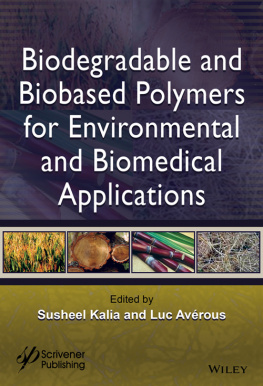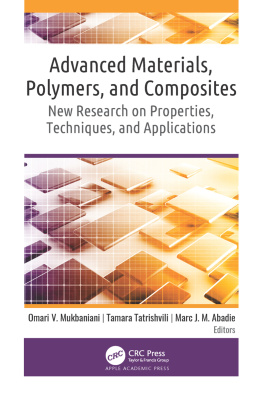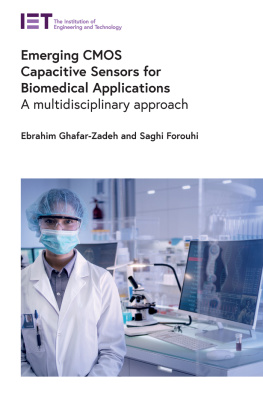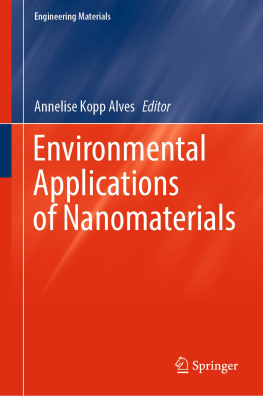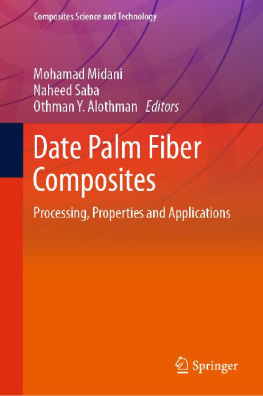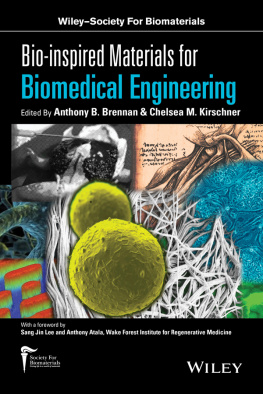Biodegradable and Biobased Polymers for Environmental and Biomedical Applications
Scrivener Publishing
100 Cummings Center, Suite 541J
Beverly, MA 01915-6106
Publishers at Scrivener
Martin Scrivener ()
Phillip Carmical ()
Copyright 2016 by Scrivener Publishing LLC. All rights reserved.
Co-published by John Wiley & Sons, Inc. Hoboken, New Jersey, and Scrivener Publishing LLC, Salem, Massachusetts.
Published simultaneously in Canada.
No part of this publication may be reproduced, stored in a retrieval system, or transmitted in any form or by any means, electronic, mechanical, photocopying, recording, scanning, or otherwise, except as permitted under Section 107 or 108 of the 1976 United States Copyright Act, without either the prior written permission of the Publisher, or authorization through payment of the appropriate per-copy fee to the Copyright Clearance Center, Inc., 222 Rosewood Drive, Danvers, MA 01923, (978) 750-8400, fax (978) 750-4470, or on the web at www.copyright.com . Requests to the Publisher for permission should be addressed to the Permissions Department, John Wiley & Sons, Inc., 111 River Street, Hoboken, NJ 07030, (201) 748-6011, fax (201) 748-6008, or online at http://www.wiley.com/go/permission .
Limit of Liability/Disclaimer of Warranty: While the publisher and author have used their best efforts in preparing this book, they make no representations or warranties with respect to the accuracy or completeness of the contents of this book and specifically disclaim any implied warranties of merchantability or fitness for a particular purpose. No warranty may be created or extended by sales representatives or written sales materials. The advice and strategies contained herein may not be suitable for your situation. You should consult with a professional where appropriate. Neither the publisher nor author shall be liable for any loss of profit or any other commercial damages, including but not limited to special, incidental, consequential, or other damages.
For general information on our other products and services or for technical support, please contact our Customer Care Department within the United States at (800) 762-2974, outside the United States at (317) 572-3993 or fax (317) 572-4002.
Wiley also publishes its books in a variety of electronic formats. Some content that appears in print may not be available in electronic formats. For more information about Wiley products, visit our web site at www.wiley.com .
For more information about Scrivener products please visit www.scrivenerpublishing.com .
Library of Congress Cataloging-in-Publication Data:
ISBN 978-1-119-11733-9
Preface
The use of renewable biobased carbon feedstock is seriously taken into consideration these days because it offers the intrinsic value of a reduced carbon footprint and an improved life cycle analysis, within the framework of a sustainable and environmental development. That is why new and future chemicals and materials for daily applications are obtained more and more from the biomass. These biobased products with particular chemical architectures succeed as a good alternative to conventional and fossil-based chemical feedstock. Keeping in mind the deteriorating environmental conditions, researchers all over the world are focusing their efforts on biodegradable and biobased polymers. Plastic waste and its disposal is one of the major environmental problems in industrial development. Researchers have focused on biobased materials that can easily be biodegraded and only few publications in book form are available on biodegradable and biobased polymers for the benefit of the greater public. This book is a a unique volume with contributions from many renowned experts in this area of research. It begins with an introduction that summarizes the importance of biodegradable and biobased polymers in the market. The volume covers almost all the topics related to biodegradable and biobased polymers for environmental and biomedical applications. It will prove to be a very useful tool for scientists, academicians, research scholars, polymer engineers and industries. The first chapter describes the most recent researches on applications, and new developments in biomedical and pharmaceutical areas of thermoplastic starch. Application of polyhydroxyalkanoates in agriculture, biodegradable packaging material and biomedical field like drug delivery systems, implants, tissue engineering, development of scaffolds are reviewed in Chapter 2. The third chapter covers the synthesis and elaboration of cellulose microfibrils from sisal fibres and the corresponding PLA biocomposites. The authors suggest the use of such materials for high performance engineering applications in various sectors such as the automotive and aerospace industries, or for building and construction. Chapter 4 summarizes the different classes and chemical modifications of tannins. The main chemical pathways to obtain aromatic materials with specific macromolecular architectures are more particularly presented in this chapter. Electroactivity and applications of Jatropha latex and seed are discussed in chapter 5. Jatropha latex is a high- potential biomaterial for direct generation of power and has high medicinal value. The use of Jatropha latex in various green techniques to develop nanoparticles of metallic compound is also reported here. Chapter 6 deals with synthesis, properties and applications of poly(lactic acid). Chapter 7 focuses on the synthesis, processing and properties of poly(butylene succinate), its copolymers, composites and nanocomposites. The biodegradability and applications of poly(butylene succinate) are also discussed here. Chapter 8 includes the various routes for preparation polymers from vegetable oil. The effects of reinforcement and nano-reinforcement on the physical properties of such biobased polymers are also highlighted in this chapter. The different types of modified drug delivery systems together with the concept of the drug delivery matrix are discussed in Chapter 9. Polysaccharides, modified polysaccharides and cellulose nanocrystals as carriers for drug delivery systems are also reported here. Applications of such drug delivery systems as potential carriers for controlled release of drugs and for antitumor drugs are also discussed. Chapter 10 summarizes the use of nanocellulose as sustainable adsorbents for the removal of water pollutants mainly heavy metal ions, organic molecules, dyes, oil and CO2. Chapter 11 describes the main extraction techniques, structure, properties and different chemical modifications of lignins. Lignin is an interesting and trendy aromatic building block which can be integrated inside the architecture of different macromolecules by chemical means to obtain new aromatic polymers with high performances. Proteins and nucleic acid-based biopolymers are reported in chapter 12. The role of tamarind seed polysaccharide-based multiple-unit systems in sustained drug release is elaborated in chapter 13.
The editors would like to express their appreciation to all chapter authors of this book who have provided excellent contributions. The editors would like to thank their research teams who helped them in the editorial work. Finally, we gratefully acknowledge permissions to reproduce copyright materials from a number of sources.
Dr. Susheel Kalia, Dehradun, India
Prof. Luc Averous, Strasbourg,
France
December 1, 2015
Chapter 1
Biomedical Applications for Thermoplastic Starch

